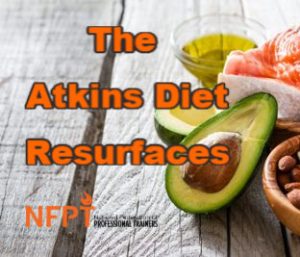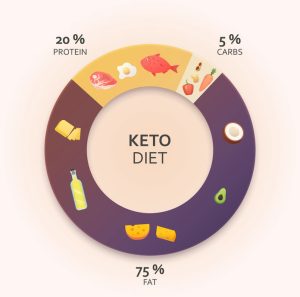As the keto craze rages on, let’s take the opportunity to discuss another low-carb diet variation with plenty of merit and proven success as a weight loss approach: The Atkins’ Diet.

History of the Atkins Diet
The Atkins’ diet was created in the early 1970’s by the late Dr. Robert C. Atkins (1930-2003), a cardiologist and internist. The diet was popularized through the publication of Dr. Atkins’ Diet Revolution book and helped many with weight loss. Since then, the book has been updated several times and Dr. Atkins has written many more on the topic.
Having graduated from Cornell University, Atkins and his colleagues researched his diet extensively. In 1990, Dr. Atkins received the World Organization of Alternative Medicine Recognition of Achievement Award. There have been other recognitions as well, but despite it long-standing history, the diet is not without controversy.
Although he passed away as a result of complications from a surgery trying to remove a blood clot from his brain after a fall, Dr. Atkins had a documented history of heart attack, congestive heart failure, and hypertension. An autopsy was refused by his family as is customary in Jewish tradition.
All discussion of the diet’s founder aside, there remains several myth-busting and factual information about the diet that could be beneficial to fitness professionals. There are plenty of people jumping on the low-carb band wagon these days and the Atkin’s diet is one of them.
The Atkins Diet Explained
The Atkins diet has many similarities to the ketogenic diet and some key differences that make it a bit more flexible and user-friendly. Like ketogenic diets, the Atkins diet is not a fad. It has been in use for 50+ years and as late as 2016, the New York Times wrote an article titled: “How the Sugar Industry Shifted Blame to Fat”, substantiating that maybe dietary fat isn’t so bad for us after all. But, how we go about preparing it, eating it, and approaching our relationship with dietary fat is.
The ketogenic diet was originally founded and used as a method to treat epilepsy and more recently, people have started using it for weight loss. The Atkins Diet was created for weight loss and has been adapted by the medical community as a Modified Atkins Diet (MAD) to help people with epilepsy who need a more flexible way of eating than a strict keto diet and yet adhered to the aspects of keto that mitigate their symptoms.
The ketogenic diet focuses on high-fat, moderate-protein, low-carbohydrate macronutrient intake in order to induce a metabolic

Ketogenic diet diagram. Healthy fats should vary between 70-80% of daily energy intake.
state of ketosis whereby the body switches from its primary source of fuel coming from carbohydrates to fat. There is also emphasis placed on macronutrient ratios with fat being calculated to 70-80% of a person’s dietary intake. In the Atkins diet, fat intake is less than keto and the focus is to be more aware of carbohydrate intake rather than track it strictly.
The quality of calories eaten versus the quantity is also a highlight of the Atkins Diet. The diet is broken into step-by-step phases which include direction on what to eat, how to track daily net carbohydrate intake, mind-set tools, behavioral changes, and education on how a low carbohydrate environment alters the metabolism of the human body and why this is so integral in weight loss.
Dr. Atkins also encouraged movement and exercise for anyone with weight-loss goals. For those who have medical complications as a result of being clinically obese or overweight such as diabetes and metabolic syndrome, he encouraged consulting with a properly credentialed medical professional before starting the program. These individuals can monitor the medical condition and order laboratory testing as needed. Atkins also encouraged people to choose a goal weight relevant to their age, hormonal changes, lifestyle, activity level, realistic to their physical frame.
Here’s a high-level quick look of the phases of the Atkins Diet:
1) Induction
2) Ongoing Weight Loss (OWL)
3a) Pre-Maintenance
3b) Maintenence
Induction Phase
During the induction phase, the main goals are to:
- Switch the body’s metabolism from using carbohydrates as a main source of fuel to fat (similar to ketosis)
- Stabilize blood sugar
- Curb carbohydrate cravings
Dr. Atkins reports calling it the induction phase in order “induce” the metabolic change we talked about so that rapid weight-loss can start happening. He outlines specific “rules” in this “Induction” phase:
- Eat three regular size meals per day or four to five smaller meals.
- Do not skip meals
- Do not eat more than 20 g per day of net carbohydrates.
- Read labels diligently and track the amount of CHO that are being ingested.
- Be mindful around gravies, dressings, sauces, and other hidden carbs.
- Do not ‘cheat.’ Cheating would shift the body away from the vital metabolic switch that needs to happen!
Some of the recommended foods from the list are:
- Poultry, fish, shellfish, eggs, and red meat.
- Pure, natural fat such as: butter, mayonnaise, olive oil, safflower, sunflower and other vegetable oils (expeller-pressed or cold-pressed is recommended).
- Low glycemic index vegetables such as leafy greens
It is recommended to stay in this phase for a minimum of 14 days and for those who are metabolically resistant or want to stay in it longer to experience the rapid weight loss in this phase, it is recommended to stay in this phase for 1-2 months. This phase is not FOREVER.
Ongoing Weight Loss Phase
During the Ongoing Weight Loss (OWL) Phase, the list of foods allowed broadens and weight-loss becomes less rapid. It is encouraged to focus on creating new lifelong habits during this phase and its main goals are:
- Continue with fat-burning efforts
- Learn your Critical Carbohydrate Level for Losing weight (CCLL)
(CCLL is the threshold level of daily carbohydrate consumption, that will allow you to continue to lose weight)
- Make proper choices and select nutrient-dense foods
- Purposely slow the rate of weight loss so that new habits can be formed and a solid foundation is laid to achieve permanent weight management
Dr. Atkins also provides a list of foods that can be eaten in this phase. The options vary more than in the induction phase. Emphasis is placed on daily tracking of net carbohydrates intake and monitoring weight loss by using a weight scale, noticing how clothes fit, and circumference measurements.
It is recommended to stay in the OWL phase until you are left with the final 4-5 pounds to lose.
Maintenance Phase
The third phase and final phase of maintenance is described mainly as a lifelong way of living. The gateway to maintenance is pre-maintenance, or the phase Dr. Atkins refers to as the “training program” for maintenance.
The main goals of pre-maintenance are to:
- Accustom yourself to a lifetime eating plan
- Determine your CCLM–the best carbohydrate level in which you can feel the happiest and healthiest without experiencing cravings and regaining weight
- Understand that your CCLL can shift and why
- Increase awareness of situations that can shift you away from your goals (i.e.: social gatherings, parties, special occasions, holidays)
- Offer an even wider variety of food choices than the other two phases
- Internalize your responses to distracting situations from your weight loss goals
- Develop flexible lifestyle eating habits and choices to help sustain your weight loss
It is recommended to stay in this phase until you lose the final 4-5 pounds and reach your weight loss goal. It is also recommended to take months to shed the final pounds in order to ‘own’ the weight loss physically and in mind-set.
In the pre-maintenance phase, the body is typically no longer in ketosis but rather continuing to burn fat some of the time as needed and to also use healthy sugars as a source of fuel. This is referred to as a metabolical efficiency.
The emphasis in this phase is still on eating foods high in fat (or shiny with healthy oils), moderate-protein, and carbohydrates that are consistent with a person’s CCLM). This phase is therefore highly individualized.
Once the goal weight is reached, the maintenance phase follows.
Dr. Atkins Explains this phase as having occurred naturally as a segue or natural progression of completing pre-maintenance. People who reach this phase reach it in their own time and it just “happens.” By this phase, a person has gone through a physical transformation that requires mind-set and lifestyle behavioral changes. It was Dr. Atkins’ hope that people would take their time through the final phases of his diet in order for the physical changes to take hold and last.
Atkins Advice for Success
Throughout his writing, he wrote about the importance of learning good eating habits and once getting past the induction phase, to reach the weight-loss goal at a leisurely pace. He encouraged people to enjoy the process and find satiating foods so that you do not have to count calories. Tracking carbohydrates functions not only to maintain the weight loss but serves as due diligence to prevent relapse of former habits that caused the initial weight gain.
For someone who feels they may be falling back into old, unhealthy habits and causing weight to creep back, he or she can be reminded that a transformation already took place once and can certainly happen again. The second time around, with the integration of many new habits that have resulted in successful weight loss, it won’t be as much an odyssey as the first.
Fad Fallacy
If Dr. Atkins spends time encouraging his dieters to “take their time” when writing about his program, why do many perceive his diet as a “fad”? Did people spend too much time hyping up the induction phase, where the recommendation is to not eat more than 20g of net carbohydrates?
If weight-loss is your client’s goal and they are considering a low-carbohydrate alternative to ketogenic diets or are already on Atkins, I strongly recommend learning more about the Atkins diet. It seems like yet another diet that’s unfairly fallen into the abyss of misnomers crowding the low-carb bandwagon.
**This blog is educational in nature only and does not serve as medical advice or replace a session with a credentialed nutrition professional. In specific diets such as The Atkins Diet, there are considerations to take such as hydration, electrolytes, supplementation, and whether a specific way of eating fits well with your composition, lifestyle, and any existing medical condition. As with any lifestyle change or specific way of eating, the risk of side effects exists. A credentialed professional would also be in a position to order laboratory testing and do other monitoring as needed. This blog does not intend to replace these services.**
References:
Atkins, R. C. (2002). Dr. Atkins’ new diet revolution: The low-carb approach that has helped millions lose weight and keep it off. New York, NY: Harpers Collins.
https://www.nutricialearningcenter.com/globalassets/pdfs/neurology/webinar-slides_mad_may2017.pdf?epieditmode=False
Kosoff, E. H., Turner, Z., Doerrer, S., Cervenka, M. C., & Henry, B. J. (2016). The ketogenic and modified atkins diets: Treatments for epilepsy and other disorders. New York, NY: Demos Health
Sharma, S., & Jain, P. (2014). The modified atkins diet in refractory epilepsy. Epilepsy Research and Treatment, retrieved from: https://www.ncbi.nlm.nih.gov/pmc/articles/PMC3929267/
Shaweta “Shay” Vasudeva, MA (Psychology), MS (Kinesiology), NFPT-CPT, NASM-CPT-CES, THSA-CNT, and Tai Chi & Black Belt Karate Instructor is a teaching professional, speaker, author, coach, and cat lover! Her passion is to help people become the best version of themselves by using an interdisciplinary and holistic approach, bringing 10+ years of experience in Psychology, Personal Fitness Training, Corrective Exercise, Nutritional Coaching, Cranial Sacral Work, and teaching Karate & Tai Chi classes to her business, ShayTheCoach. Shay teaches classes at Maricopa Community College District as an Adjunct Professor. For more information visit her personal webpage: www.shaythecoach.com

